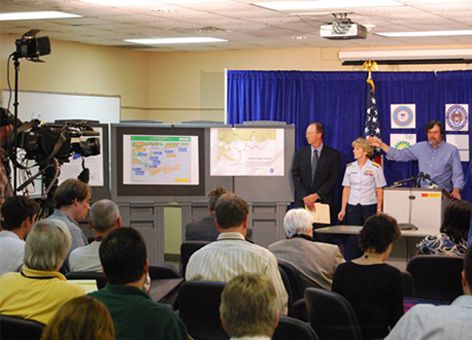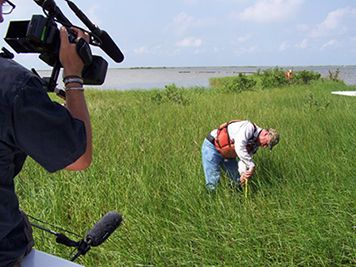Are We Prepared to Communicate Well During the Next Disaster?
SEPTEMBER 27, 2013 -- Ever had a crisis? Did you have a plan for getting people the information they needed during that crisis? Chances are you answered first yes, then no. It is not often we are able to anticipate what our next crisis or disaster will be, but that doesn't mean we should be caught off guard (however unusual the event). The Office of Response and Restoration (OR&R) is no stranger to dealing with crisis. Whether it's an oil spill, influx of marine debris, or chemical release, we plan and prepare to deal with environmental disasters as a part of our work each day. As environmental disasters continue to happen and media coverage becomes more instantaneous, we must also be prepared to communicate with the public about these disasters in a way that is factual, timely, and helpful. On September 19, 2013, OR&R's Kate Clark was able to attend a crisis communications workshop sponsored by the Ad Council. It featured three esteemed and accomplished communication experts: Dee Dee Myers, Managing Director of the Glover Park Group and former White House Press Secretary; Camille Johnston, Vice President, Corporate Affairs for Siemens Corporation and former spokesperson for First Lady Michelle Obama; and Morgan Binswanger, Executive Vice President, Government Relations and External Affairs for the LIVESTRONG Foundation. As OR&R works to improve our crisis communication strategy and strengthen our rapport with stakeholders, we thought these five pieces of advice from the seminar would help inform our efforts:
- Outreach. Using the time leading up to a crisis to educate the public, stakeholders, and the press about your mission can save a lot of valuable time during the crisis. This will allow for clearer and more germane dialogue when a crisis does occur.
- Plan ahead. What is the most likely crisis scenario? Who will speak for the organization? How we will disseminate information?
- Time is of the essence. Information is available through social media within seconds of an event occurring. This leaves a small window of time to react and respond.
- Be transparent. In today's day and age, almost everything becomes public, so transparency and honesty in the very early stages are crucial to maintaining trust and credibility.
- Humility goes a long way. It's OK to say, "We don't know, but we are working very hard to get an answer."
OR&R and the whole NOAA family is constantly learning and adapting to the changing pace of communications in today's information landscape. Let us know how you think we're doing. Where would you look for information from NOAA during a disaster, such as a hurricane or oil spill? A blog? Facebook or Twitter? NOAA.gov? Somewhere else? We are thankful to the Ad Council for sponsoring this seminar and providing great reminders as we continually work to improve our dialogue with the people we work for—the U.S. public. Editor's Note: September is National Preparedness Month. It is a time to prepare yourself and those in your care for emergencies and disasters of all kinds. NOAA and our partners are making sure that we are prepared in every regard for whenever the next disaster strikes. To learn more about how you can be prepared for all types of emergencies, visit www.ready.gov.
 An official website of the United States government.
An official website of the United States government. 

